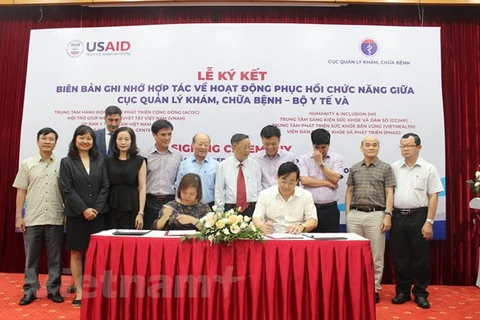Hanoi (VNA) – The amendment of policies and assistance programmes dedicated to people with disabilities will include specific policies for disabled women.
Disabled women and young girls are usually victimised by both types of discrimination towards their gender and disabilities. They face high risks of abuse and violations, which requires policies to be improved to better protect and support them.
The information was revealed during a seminar on policies and assistance for disabled women held in Hanoi on July 24 by the Office of the National Committee for Vietnamese Persons with Disabilities, Oxfam and the Vietnam Women’s Union (VWU) Central Committee.
Vietnam is home to 6.2 million people with disabilities, 58 percent of them are females. At present, more than 1 million disabled people have received monthly allowances from the Government. Notably, the rate of poor families with disabled members remains alarmingly high.
Nguyen Van Hoi, Chief of Office of the National Committee for Vietnamese Persons with Disabilities and Director of the Department of Social Assistance under the Ministry of Labour, Invalids and Social Affairs, said that despite a number of policies, many people with disabilities have yet to become beneficiaries while the rate of poor families with disabled members remains high.
Hoi noted that policies for disabled women still have holes in terms of career support, health care, rehabilitation and social integration, along with the mobilisation of resources to support those in need.
Assessments in the implementation of current policies are needed to serve as a foundation for the amendment of the law on persons with disabilities and the Decree No. 136/2013/ND-CP on social policies beneficiaries, he noted.
Hoi underlined the necessity to issue specific policies in medical examination and treatment covered by health insurance for the handicapped. At the moment, a number of orthopedic and rehabilitation services are yet to be covered by health insurance, which hinders disabled people’s access to health care.
In addition, the quality of the medical network at grassroots levels remains modest, as health clinics at communes are short on modern equipment and medicine, as well as physicians specialising in rehabilitation.
The community-based rehabilitation programme, with the health sector at community level as its core, faces various obstacles in its implementation. Only less than 10 percent of the disabled are engaged in such programmes, according to the Ministry of Health.
Phan Thi Quynh Nhu, Vice Director of the Department of Family and Social Affairs under the VWU Central Committee, said that women with disabilities mainly depend on their families, relatives and social allowances, and most of them are impoverished.
They are more likely to become victims of abuse compared to their able-bodied peers while due attention has yet been paid to their basic rights. Their access to medical and social services, health care, education, jobs and integration remain limited.
Disabled women suffer the impact of poverty triggered by gender barriers and other difficulties three times higher than their male counterparts. Even so, they always wish to bolster knowledge and capacity, affirming their position in the society, Nhu added.
The National Committee for Vietnamese Persons with Disabilities is reviewing and amending policies on vocational training and job offers and assistance for people offering support for the disabled. The adjustment will be in tandem with specific policies in gender stated in existing legal documents.
In 2021-2025, the committee strives to have 80 percent of women with disabilities receive various types of assistance. That figure will be raised to 100 percent by 2026-2030.
Furthermore, it will bolster communication campaigns on policies for the disabled to raise awareness of family and community’s responsibility, as well as create favourable conditions for the development of their organisations./.
| Vietnam is currently home to 6.2 million people with disabilities, including 29 percent with severe and extremely severe conditions. Some 90,000 handicapped children go to schools, primarily in kindergartens and high schools. Over 1,900 vocational training facilities offer courses for the disabled. About 17,000-20,000 disabled people receive training each year. In 2012-2030, the MoLISA launched a livelihood support model for 1,320 households of people with disabilities in 25 provinces and cities. |
























